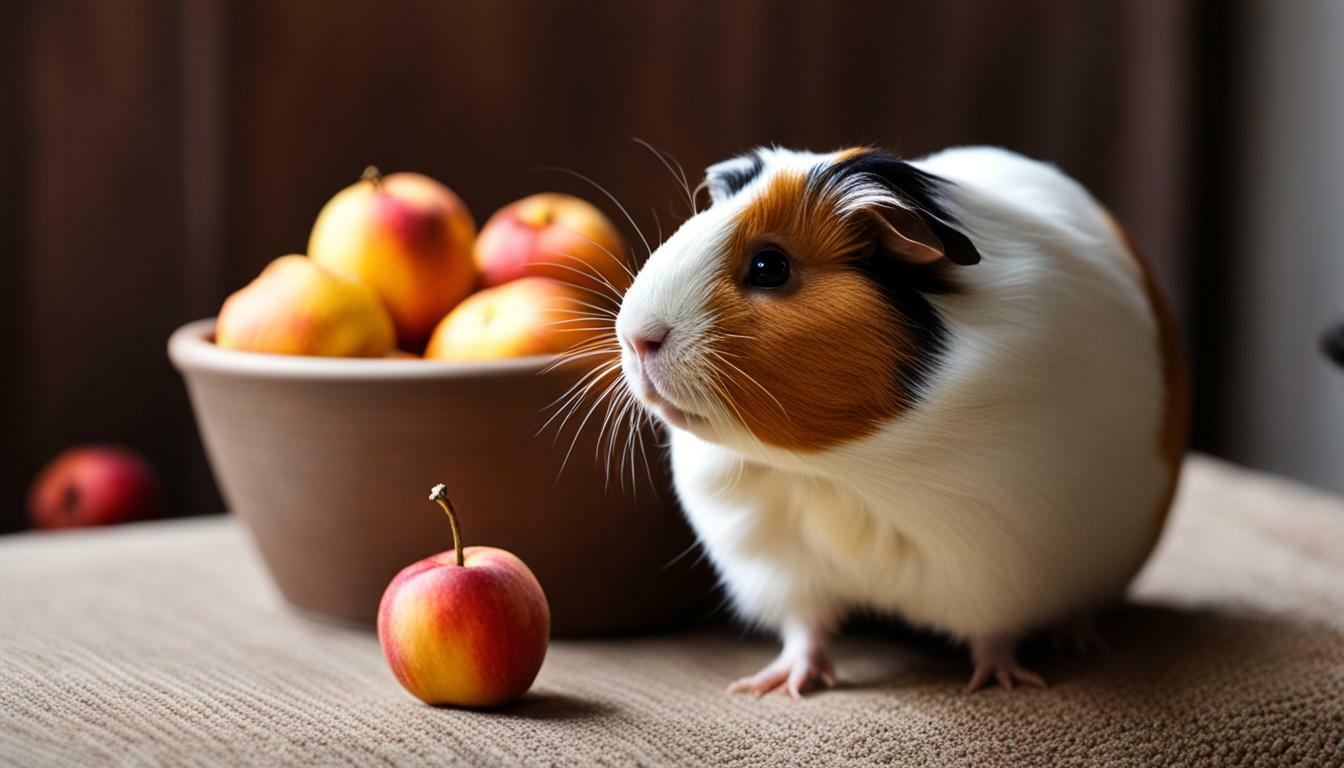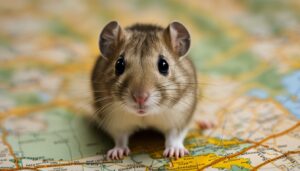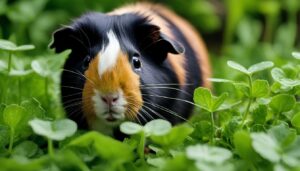Guinea pig owners often wonder if it’s safe to feed nectarines to their furry friends. While these juicy fruits can provide a tasty and nutritious treat, it’s important to understand the dos and don’ts of including nectarines in a guinea pig’s diet.
Key Takeaways:
- Guinea pigs can have nectarines, but they should be given in moderation due to their high sugar content.
- The pits of nectarines should be removed before feeding them to guinea pigs to prevent choking hazards.
- Nectarines provide energy, vitamins, and minerals that can benefit guinea pigs, such as vitamin C, vitamin A, and potassium.
- However, guinea pigs should not eat nectarines every day and should be offered a variety of fruits and vegetables to maintain a balanced diet.
- Feeding guinea pigs too many nectarines can lead to stomach aches and urinary problems, so portion control is essential.
Now that we’ve addressed the key takeaways, let’s delve deeper into the dietary needs of guinea pigs and the benefits, as well as the potential risks, of feeding them nectarines.
Understanding Guinea Pig Dietary Needs
Before delving into the topic of nectarines, it’s crucial to understand the dietary requirements of guinea pigs. These adorable little pets have unique nutritional needs that must be met for them to thrive. Guinea pigs are herbivores and rely on a diet rich in fiber to maintain healthy digestion.
Hay is the foundation of a guinea pig’s diet and should make up the majority of their food intake. It provides essential nutrients, helps wear down their constantly growing teeth, and keeps their digestive system functioning properly. Fresh, good-quality hay should be available to them at all times.
In addition to hay, guinea pigs also need a variety of fresh vegetables and leafy greens. These provide important vitamins and minerals that support their overall health. It’s important to introduce these foods slowly and in small quantities to avoid digestive upset. Some recommended vegetables for guinea pigs include bell peppers, carrots, cucumbers, and dark leafy greens like spinach and kale.
| Vitamin C | Vitamin A | Potassium |
|---|---|---|
| Supports immune system | Essential for vision and skin health | Helps regulate fluid balance and nerve function |
| Found in bell peppers, kale, and broccoli | Found in carrots, sweet potatoes, and bell peppers | Found in bananas, oranges, and spinach |
While fruits can be a tasty addition to a guinea pig’s diet, they should be given in moderation due to their high sugar content. Nectarines, for instance, can provide energy and essential vitamins and minerals like vitamin C, vitamin A, and potassium. However, they should not be an everyday treat and should only be offered occasionally. Feeding too many nectarines or other fruits can lead to stomach aches and urinary problems. It’s important to maintain a balanced diet for your guinea pig, with the majority of their nutrition coming from hay, grass, vegetables, and leafy greens.
The Benefits of Nectarines for Guinea Pigs
While high in sugar, nectarines can offer some nutritional advantages for guinea pigs. These delicious fruits are packed with essential vitamins and minerals that can contribute to their overall well-being. Nectarines are a great source of vitamin C, which is vital for guinea pigs as they cannot produce this vitamin naturally. Vitamin C helps boost their immune system and promotes healthy skin and coat.
Additionally, nectarines contain vitamin A, which is essential for good eyesight and maintaining a healthy respiratory system in guinea pigs. This nutrient is especially important for younger guinea pigs, as their developing bodies require adequate amounts of vitamin A to support proper growth and development.
Furthermore, nectarines provide potassium, a mineral that helps regulate blood pressure and supports proper heart function in guinea pigs. Potassium is also necessary for maintaining healthy muscle and nerve function, making nectarines a beneficial addition to their diet.
While the nutritional benefits of nectarines are evident, it’s important to remember that they should be given in moderation. Guinea pigs have sensitive digestive systems, and consuming excessive amounts of nectarines, or any fruit high in sugar, can lead to gastrointestinal issues and even urinary problems. Therefore, it’s crucial to provide nectarines as an occasional treat rather than a staple food in their diet.
| Nutrient | Benefits for Guinea Pigs |
|---|---|
| Vitamin C | Boosts immune system, promotes healthy skin and coat |
| Vitamin A | Aids in good eyesight and respiratory health, supports growth and development |
| Potassium | Regulates blood pressure, supports heart function, and maintains muscle and nerve health |
To serve nectarines to your guinea pig, be sure to remove the pits and wash the skin thoroughly. You can cut the nectarine into small, bite-sized pieces to make it easier for them to eat. It’s important to monitor their consumption and remove any uneaten pieces from their bowl to prevent spoilage.
Remember, while nectarines can be a tasty and nutritious treat for guinea pigs, their diet should primarily consist of hay, grass, leafy greens, and other vegetables. These foods provide the necessary fiber and nutrients that guinea pigs need to maintain a healthy digestive system and overall well-being. Treats like nectarines should be offered sparingly to ensure a balanced diet and to prevent any potential health issues.
Moderation is Key
It’s essential to remember that nectarines should be given as an occasional treat rather than a staple in a guinea pig’s diet. While nectarines can provide energy and beneficial nutrients, they are also high in sugar, which can be detrimental to the health of guinea pigs if consumed in excess. Feeding guinea pigs too many nectarines can lead to stomach aches and urinary problems. Therefore, it is crucial to practice moderation when offering nectarines to your furry friends.
When feeding nectarines to guinea pigs, it’s important to remove the pits before serving them. The pits can be a choking hazard and should be discarded. Additionally, the skin of the nectarine can be consumed by guinea pigs, but it should be thoroughly washed to remove any pesticides or dirt that may be present. Ensuring the cleanliness of the skin will help prevent any potential health issues for your guinea pigs.
To promote portion control, it’s recommended to serve nectarines in small pieces and monitor your guinea pigs’ consumption. Any uneaten nectarine pieces should be promptly removed from their bowl to prevent overeating. Remember, nectarines should be part of a varied diet that includes hay, grass, leafy greens, and other vegetables. These fibrous foods are essential for guinea pig digestion and overall well-being. While nectarines can provide a delightful treat, they should not replace the main components of a guinea pig’s diet.
| Potential Risks | Safe Feeding Practices |
|---|---|
| High sugar content leading to health issues | Feed nectarines in moderation |
| Choking hazard from pits | Remove pits before serving |
| Contaminated skin from pesticides or dirt | Thoroughly wash the nectarine skin |
| Overeating causing stomach aches | Practice portion control and remove any uneaten pieces |
In summary, while nectarines can be a tasty addition to a guinea pig’s diet, they should be given in moderation. Remove the pits and wash the skin before offering the fruit to your guinea pigs. Remember to prioritize a balanced diet consisting mainly of hay, grass, leafy greens, and vegetables. By adhering to these feeding practices, you can ensure the well-being of your beloved guinea pigs and provide them with occasional and healthy nectarine treats.
Preparing Nectarines for Guinea Pigs
Before offering nectarines to your guinea pig, it’s crucial to take a few preparatory steps to ensure their safety. Guinea pigs can consume nectarines, but it’s important to remember that they should be given in moderation due to their high sugar content. To start, always remove the pits from the nectarines before offering them to your furry friend. The pits can pose a choking hazard and should be avoided.
In addition to removing the pits, it’s essential to properly wash the nectarines to remove any pesticides or dirt residues on the skin. Guinea pigs can eat the skin of nectarines, but ensuring it’s clean is necessary to avoid any potential health issues. Wash the nectarine thoroughly under running water, gently rubbing the skin to remove any impurities.
After preparing the nectarines, it’s advisable to cut them into small, bite-sized pieces for your guinea pig. This ensures they can easily consume the fruit without any difficulty. It’s important to offer nectarines in small amounts, as too much fruit can lead to stomach aches and urinary problems. Any uneaten pieces of nectarine should be promptly removed from the cage to maintain cleanliness and prevent the growth of harmful bacteria.
Table: Safe Fruits and Vegetables for Guinea Pigs
| Fruits | Vegetables |
|---|---|
| Apples | Carrots |
| Bananas | Bell Peppers |
| Blueberries | Cucumbers |
| Grapes | Kale |
| Strawberries | Parsley |
While nectarines can be a nutritious addition to your guinea pig’s diet, it’s important to remember that they should not be the sole focus. Guinea pigs require a balanced diet consisting mainly of hay, grass, leafy greens, and vegetables. Fruits like nectarines should be considered occasional treats rather than regular components of their daily meals. By providing a well-rounded diet, you can ensure that your guinea pig remains healthy and happy.
Portion Control and Monitoring Consumption
To prevent stomach aches and urinary problems, it’s crucial to control the portion sizes and monitor how much nectarine your guinea pig eats. While nectarines can provide a tasty and nutritious treat for your furry companion, they should be given in moderation due to their high sugar content. Too much sugar can lead to gastrointestinal issues and even obesity in guinea pigs. It’s important to remember that nectarines should not be a staple in your guinea pig’s diet, but rather an occasional addition.
When feeding nectarines to your guinea pig, it’s advisable to serve them in small sizes. This ensures that your pet doesn’t consume excessive amounts of sugar in one sitting. Additionally, any uneaten pieces of nectarine should be removed from the bowl to prevent overeating or spoilage. By offering controlled portions and removing uneaten fruit, you can help maintain your guinea pig’s optimal health.
While nectarines can be a delightful treat, it’s essential to balance their intake with other fruits and vegetables. Guinea pigs require a varied diet that includes hay, grass, leafy greens, and other vegetables to meet their nutritional needs. Fruits, including nectarines, should only constitute a small portion of their diet. Remember, moderation and variety are key to ensure a healthy and well-rounded diet for your guinea pig.
Table: Safe Fruits for Guinea Pigs
| Fruit | Frequency |
|---|---|
| Nectarines | Occasional treat |
| Apples | Occasional treat |
| Strawberries | Occasional treat |
| Blueberries | Occasional treat |
| Watermelon | Occasional treat |
Remember to always consult with a veterinarian to ensure you’re providing the best diet for your guinea pig. They will be able to offer personalized advice and guidance based on your pet’s specific needs and overall health. By maintaining portion control and monitoring your guinea pig’s nectarine consumption, you can ensure a happy and healthy companion for years to come.
The Role of Other Foods in a Guinea Pig’s Diet
While nectarines can be a tasty addition to a guinea pig’s diet, it’s important to remember that they should not replace the essential foods that make up their regular diet. Guinea pigs require a balanced and varied diet to ensure they receive all the necessary nutrients for optimal health. Alongside nectarines, there are other fruits and vegetables that can be included in a guinea pig’s menu.
A guinea pig’s diet should primarily consist of hay, grass, and leafy greens. These fibrous foods help with digestion and provide the necessary roughage for their dental health. Timothy hay, in particular, is highly recommended for guinea pigs as a staple food. It helps to wear down their continuously growing teeth and keeps their gastrointestinal system functioning properly.
When it comes to leafy greens, options such as romaine lettuce, spinach, kale, and cilantro can be included to provide additional vitamins and minerals. These greens should be washed thoroughly before feeding to remove any pesticides or contaminants. A variety of vegetables like bell peppers, carrots, and zucchini can also be offered in small amounts to provide additional nutrients.
| Foods to Include in a Guinea Pig’s Diet | Benefits |
|---|---|
| Timothy hay | Aids in digestion and promotes dental health |
| Leafy greens (e.g., romaine lettuce, spinach, kale, cilantro) | Provides vitamins and minerals |
| Vegetables (e.g., bell peppers, carrots, zucchini) | Offers additional nutrients |
It’s crucial to remember that guinea pigs have unique dietary needs, and not all fruits and vegetables are suitable for them. Some foods, like onions, garlic, and avocado, should be avoided as they can be toxic to guinea pigs. Always consult with a veterinarian to ensure you are providing a safe and appropriate diet for your furry friend.
Potential Risks and Considerations
Although nectarines can provide benefits, there are some risks and considerations to keep in mind to ensure the health of your guinea pig. While nectarines contain essential vitamins and minerals, they are also high in sugar. Feeding your guinea pig too many nectarines can lead to stomach aches and urinary problems. Therefore, it is important to offer nectarines in moderation as an occasional treat.
In addition to moderation, it is crucial to remove the pits of nectarines before feeding them to your guinea pig. The pits can pose a choking hazard and should never be consumed by your pet. To prepare nectarines for your guinea pig, simply slice the fruit into small, bite-sized pieces, ensuring that all pits are removed.
While guinea pigs can eat the skin of nectarines, it is important to wash the fruit thoroughly before feeding it to your pet. This will remove any potential pesticides or contaminants that may be present on the skin. After washing, serve the nectarine pieces in small sizes to prevent overconsumption. Any uneaten pieces should be removed from the bowl to avoid spoiling and potential health issues.
Remember, a guinea pig’s diet should primarily consist of hay, grass, leafy greens, and vegetables. Fruits, including nectarines, should only be given as occasional treats. Providing a balanced diet will ensure your guinea pig’s overall health and wellbeing. If you have any concerns or questions about feeding nectarines to your guinea pig, it is always best to consult with a veterinarian specializing in small animals.
| Potential Risks and Considerations |
|---|
| Nectarines are high in sugar, so they should be given in moderation. |
| Remove the pits of nectarines before feeding them to your guinea pig to prevent choking hazards. |
| Wash the nectarines thoroughly before serving them to remove any potential pesticides or contaminants. |
| Offer nectarines in small sizes and remove any uneaten pieces from the bowl to prevent spoilage and health issues. |
| Ensure that the guinea pig’s diet consists primarily of hay, grass, leafy greens, and vegetables, with fruits being occasional treats. |
Conclusion
Providing nectarines to your guinea pig as an occasional treat can be a delightful way to diversify their diet, but remember to prioritize their overall nutritional needs for optimal health.
Guinea pigs can have nectarines, but it’s important to offer them in moderation due to their high sugar content. Remove the pits before feeding nectarines to your furry friend, as they can pose a choking hazard. These juicy fruits provide guinea pigs with energy, as well as essential vitamins and minerals like vitamin C, vitamin A, and potassium, which can contribute to their well-being.
However, it’s crucial to avoid feeding nectarines to guinea pigs every day. These little bundles of joy should have a balanced diet that primarily consists of hay, grass, leafy greens, and vegetables. Overconsumption of nectarines can lead to stomach aches and urinary problems, so it’s best to serve them in small pieces. Additionally, any uneaten nectarine should be removed from their food bowl.
While guinea pigs can eat the skin of nectarines, it’s essential to wash it thoroughly to remove any dirt or pesticide residue. Remember to prioritize a well-rounded diet for your guinea pig’s overall health, where fruit is just one component. Offering a variety of other fruits and vegetables alongside nectarines can provide a wider range of nutrients and flavors for your furry companion.
In conclusion, while it’s fine to treat your guinea pig with nectarines occasionally, remember that their main diet should consist of hay, grass, leafy greens, and vegetables. By following these guidelines and maintaining portion control, you can ensure your guinea pig enjoys the occasional sweet treat while staying healthy and happy.
FAQ
Can guinea pigs have nectarines?
Yes, guinea pigs can have nectarines, but in moderation.
Should the pits be removed before feeding nectarines to guinea pigs?
Yes, it is important to remove the pits of nectarines before feeding them to guinea pigs.
What benefits do nectarines provide for guinea pigs?
Nectarines provide energy, vitamins, and minerals, such as vitamin C, vitamin A, and potassium, which can benefit guinea pigs.
Can guinea pigs eat nectarines every day?
No, guinea pigs should not eat nectarines every day. They should be given other fruits and vegetables to maintain a balanced diet.
What problems can arise from feeding guinea pigs too many nectarines?
Feeding guinea pigs too many nectarines can lead to stomach aches and urinary problems.
Can guinea pigs eat the skin of nectarines?
Yes, guinea pigs can eat the skin of nectarines, but it should be washed properly before feeding them.
How should nectarines be served to guinea pigs?
Nectarines can be served in small sizes, and any uneaten pieces should be removed from the bowl.
What should be the main diet for guinea pigs?
The main diet for guinea pigs should consist of hay, grass, leafy greens, and vegetables, with fruit being an occasional treat.
Are there any risks or considerations when feeding nectarines to guinea pigs?
Potential risks include stomach aches and urinary problems. It is important to feed nectarines in moderation and monitor their consumption.




